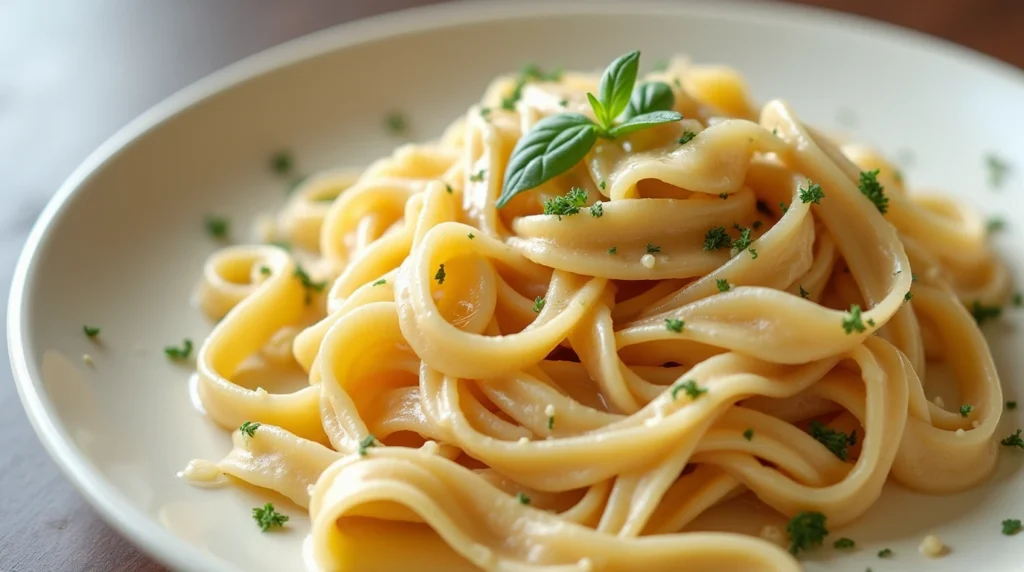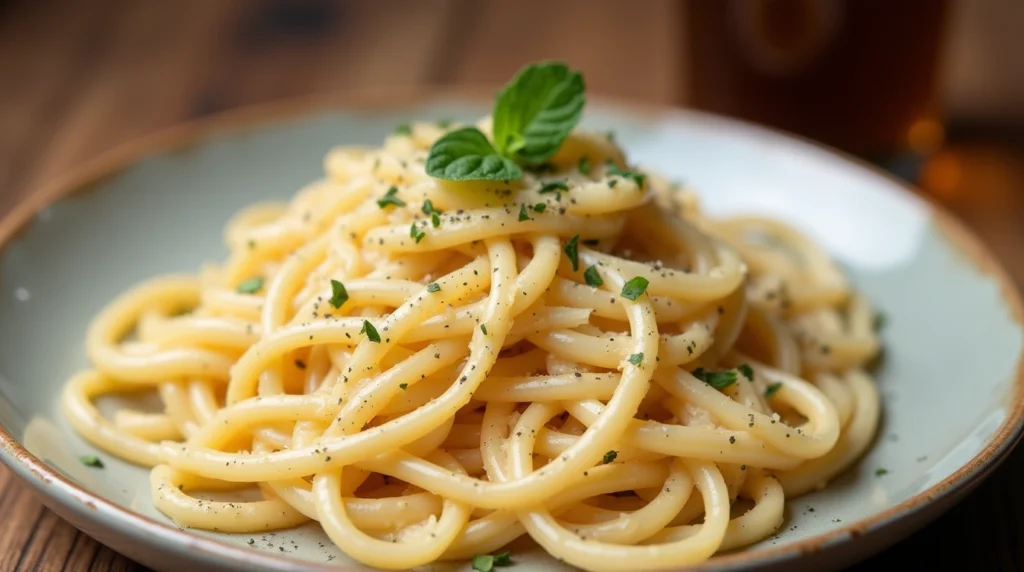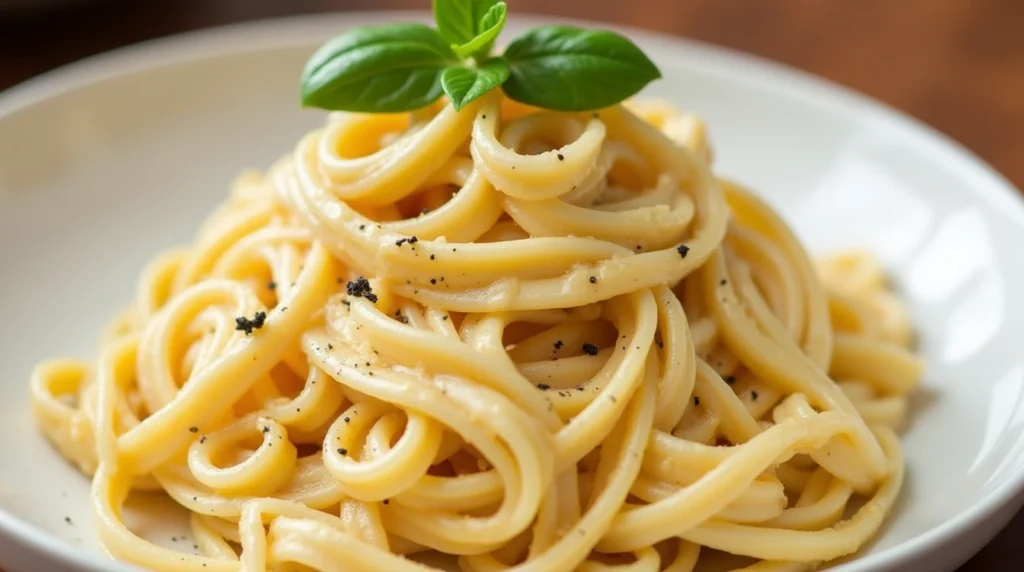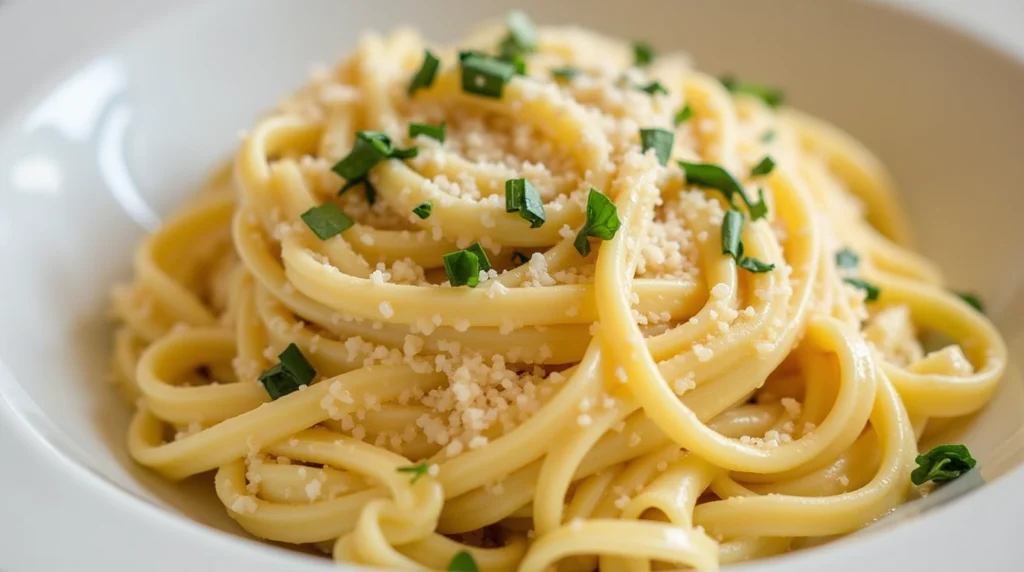Introduction

There’s something truly magical about the way creamy fettuccine carbonara can transport you straight to the heart of Italy. Imagine sitting at a cozy trattoria in Rome, savoring every bite of this rich, velvety pasta dish that seems so simple yet utterly divine. Now imagine recreating that same experience in your own kitchen—yes, it’s possible! Whether you’re a seasoned home cook or just starting out, mastering this classic recipe will leave you feeling like a culinary pro. Let me guide you through the process step by step, ensuring you end up with a plateful of pure comfort.
Understanding the Ingredients of Creamy Fettuccine Carbonara
To create an authentic and irresistible carbonara, understanding its key components is crucial. Here’s what makes this dish so special:
The Role of Fresh Fettuccine Pasta
- Why Freshness Matters: Using fresh fettuccine gives your dish a superior texture and flavor. If fresh isn’t available, high-quality dried options from brands like Barilla or De Cecco work beautifully.
- Al Dente Texture: Cooking pasta al dente ensures it holds up against the creamy sauce without becoming mushy.
- Tip: Always check the package instructions for optimal cooking times.
Cheese Choices – Parmesan vs. Pecorino Romano
- Pecorino Romano: This salty, sharp cheese is traditionally used in Roman recipes for its bold flavor.
- Parmigiano-Reggiano: For those who prefer a milder taste, Parmesan is an excellent substitute.
- Grating Tips: Use a microplane grater for finer shavings, which melt more evenly into the sauce.
Pancetta vs. Bacon – Which One Should You Use?
- Pancetta: Historically preferred in Italy due to its richer, fattier profile.
- Bacon: A convenient alternative if pancetta isn’t readily available; choose thick-cut slices for better texture.
- Preparation: Cut pancetta or bacon into small cubes and sauté until golden brown but not burnt.
Other Essential Ingredients
- Eggs: They act as the binding agent, creating the creamy consistency without needing heavy cream.
- Black Pepper: Freshly ground black pepper adds depth and complements the richness of the dish.
- Optional Garlic: A pinch of minced garlic enhances aroma without overpowering the other flavors.
Step-by-Step Guide to Making Creamy Fettuccine Carbonara
Let’s dive into the methodical steps to bring this masterpiece to life:
Preparing Your Ingredients
- Gather all your ingredients before starting:
- 400g fettuccine
- 150g grated Pecorino Romano (or Parmesan)
- 4 large eggs (or egg yolks for extra creaminess)
- 100g pancetta (or bacon), diced
- Freshly ground black pepper
- Salt for boiling water
- In a mixing bowl, whisk together the eggs and cheese until smooth. Set aside.
Cooking the Pasta Perfectly
- Bring a large pot of salted water to a boil. Add the fettuccine and cook according to package instructions until al dente.
- Reserve about ½ cup of pasta water before draining the rest. This starchy liquid helps emulsify the sauce later.
Sautéing Pancetta or Bacon
- Heat a large skillet over medium heat. Add the pancetta or bacon and cook until crispy, stirring occasionally.
- Remove excess grease using paper towels to prevent the dish from becoming too oily.
Combining Everything for a Silky Sauce
- Once the pasta is cooked, transfer it directly to the skillet with the pancetta.
- Turn off the heat and pour the egg-cheese mixture over the hot pasta. Toss gently to combine, allowing the residual heat to cook the eggs without scrambling them.
- If needed, add reserved pasta water one tablespoon at a time to achieve your desired consistency.
- Finish with generous amounts of freshly ground black pepper.
| Ingredients | Quantity |
|---|---|
| Fettuccine | 400g |
| Pecorino Romano | 150g |
| Eggs | 4 |
| Pancetta | 100g |
| Black Pepper | To taste |
| Salt | As needed |
Common Mistakes to Avoid When Making Carbonara
Even experienced cooks can stumble when preparing carbonara. Here’s how to steer clear of common pitfalls:
Scrambling the Eggs
- What Happens: Adding raw eggs to excessively hot pasta can cause them to scramble instead of forming a creamy sauce.
- How to Prevent: Ensure the pasta has been removed from direct heat before combining it with the egg mixture.
Overcooking the Pancetta
- Problem: Burning pancetta ruins its flavor and introduces bitterness to the dish.
- Solution: Cook slowly on medium heat and monitor closely.
Ignoring Pasta Water
- Importance: Starchy pasta water acts as a natural thickener, helping bind the ingredients together.
- Usage Tip: Start with small quantities and adjust gradually.
Skipping Freshly Ground Pepper
- Reason: Pre-ground pepper lacks the aromatic intensity of freshly cracked peppercorns.
- Best Practice: Invest in a good-quality pepper mill for consistent results.

Variations and Customizations for Your Carbonara
While traditional carbonara is hard to beat, there’s room for creativity depending on dietary preferences or personal tastes:
Creamless Carbonara
- Emphasize the natural creaminess achieved through eggs and cheese alone.
- Remind readers that adding cream alters the authenticity of the dish.
Vegan Carbonara Alternatives
- Replace animal-derived ingredients with plant-based substitutes:
- Nutritional yeast for cheesy flavor.
- Smoked tofu or mushrooms to mimic pancetta.
Gluten-Free Options
- Opt for certified gluten-free fettuccine made from rice, corn, or quinoa flour.
- Verify all other ingredients are free from cross-contamination risks.
Adding Vegetables for Extra Flavor
- Incorporate peas, spinach, or cherry tomatoes for added nutrition and color.
- Balance additional elements carefully to preserve the original essence of the dish.
Serving Suggestions and Pairings for Creamy Fettuccine Carbonara
Now that your carbonara is ready, let’s talk about how to serve it for maximum enjoyment:
Side Dishes to Complement Carbonara
- Serve alongside a crisp mixed greens salad dressed with olive oil and balsamic vinegar.
- Offer warm garlic bread or bruschetta for soaking up leftover sauce.
Dessert Ideas After a Hearty Meal
- Conclude the meal with light yet satisfying desserts like tiramisu or panna cotta.
- Highlight the importance of balancing heavy main courses with refreshing finishes.
Storing Leftovers Properly
- Store cooled leftovers in an airtight container in the refrigerator for up to three days.
- Reheat gently in a pan with a splash of milk or water to restore creaminess.
Deeper Dive into the Origins of Creamy Fettuccine Carbonara
Before we delve further into the nuances of making this dish, let’s take a moment to appreciate its fascinating history.
The Post-War Roots of Carbonara
Carbonara is believed to have originated in Rome during or after World War II. Some historians suggest that American soldiers stationed in Italy introduced eggs and bacon (or similar ingredients) to local cooks, who then adapted them into what became carbonara. Others argue that it was created by coal miners (“carbonai” in Italian), who used readily available ingredients like eggs, cheese, and cured pork to make hearty meals. Regardless of its exact origins, carbonara has become synonymous with Roman cuisine and remains one of Italy’s most beloved dishes.
Why It Stands Out Among Pasta Recipes
Unlike many other pasta dishes, carbonara relies on simplicity to shine. Its minimalistic approach—using just a handful of high-quality ingredients—highlights the importance of freshness and balance. For instance:
- The richness of pancetta contrasts beautifully with the sharpness of Pecorino Romano.
- Freshly ground black pepper adds a peppery kick without overpowering the dish.
- Eggs provide a creamy texture without requiring heavy cream or butter.
This harmony of flavors makes carbonara uniquely satisfying, whether enjoyed as a quick weeknight dinner or a special occasion meal.
Advanced Techniques for Perfect Carbonara
While the basic recipe is straightforward, mastering advanced techniques can elevate your dish to new heights.
Achieving the Ideal Sauce Consistency
The secret to a velvety carbonara lies in controlling the temperature of your ingredients. Here’s how:
- Tempering the Eggs: Before adding the egg mixture to the hot pasta, mix in a small amount of the reserved pasta water. This gradual introduction prevents scrambling.
- Using Residual Heat: Remove the skillet from direct heat before tossing the pasta with the egg mixture. The residual warmth will gently cook the eggs without overheating them.
- Adjusting Texture: If the sauce feels too thick, add more pasta water, a tablespoon at a time, until it reaches your desired consistency.
Maximizing Flavor Development
Small adjustments can significantly enhance the taste of your carbonara:
- Toast Your Cheese: Lightly toast grated Pecorino Romano or Parmesan in a dry pan for a few seconds to deepen its flavor profile.
- Infuse Garlic Oil: Sauté minced garlic in olive oil before adding pancetta. Strain out the garlic before proceeding to avoid bitterness.
- Season Liberally: Don’t skimp on freshly ground black pepper—it’s essential for balancing the richness of the dish.

Troubleshooting Common Issues
Even with careful preparation, things can occasionally go awry. Here’s how to troubleshoot some common problems:
Fixing Scrambled Eggs
If your eggs accidentally scramble, don’t panic! You can salvage the dish by:
- Removing the scrambled bits and setting them aside.
- Restarting the sauce-making process with fresh eggs.
- Incorporating the scrambled bits back into the finished dish as a topping.
Reviving Over-Salted Pasta Water
Accidentally oversalting your pasta water? Try these remedies:
- Add unsalted butter or cream to counteract the saltiness.
- Dilute the sauce with plain water or milk, then re-emulsify with additional cheese.
Restoring Dry Carbonara
If your carbonara turns out too dry, simply reintroduce reserved pasta water or a splash of milk. Stir vigorously to redistribute moisture evenly throughout the dish.
Cultural Variations Around the World
While carbonara is quintessentially Italian, chefs worldwide have put their own spins on the classic recipe. Here are a few examples:
French-Inspired Carbonara
In France, variations often incorporate crème fraîche or Gruyère cheese for added indulgence. These additions result in a richer, creamier sauce that appeals to those who prefer decadent flavors.
Asian Fusion Carbonara
Asian-inspired carbonara might include soy sauce, sesame oil, or even kimchi for a tangy twist. Some versions substitute traditional noodles like udon or soba for fettuccine, creating a unique cross-cultural experience.
Mexican-Influenced Carbonara
Chefs in Mexico have experimented with chorizo instead of pancetta and cotija cheese in place of Pecorino Romano. Cilantro and lime juice add vibrant freshness to this bold adaptation.
Healthier Alternatives Without Compromising Flavor
For health-conscious individuals, there are several ways to lighten up carbonara without sacrificing taste:
Using Whole Grain or Gluten-Free Pasta
Switching to whole grain or gluten-free fettuccine provides fiber and nutrients while still delivering the same comforting texture. Brands like Jovial or Tinkyada offer excellent options.
Reducing Fat Content
To cut down on fat, use leaner cuts of pancetta or limit the quantity. Alternatively, replace half the pancetta with mushrooms for a meatless option that mimics the umami flavor.
Adding Vegetables for Nutrition
Peas, spinach, zucchini, or cherry tomatoes not only boost nutrition but also add color and variety to the dish. Just be mindful of proportions to maintain the dish’s integrity.
Hosting a Carbonara-Themed Dinner Party
Once you’ve perfected your technique, why not share your skills with friends and family? Here’s how to plan a memorable carbonara-themed gathering:
Menu Planning
Start with antipasti like bruschetta or marinated olives, followed by your star attraction—creamy fettuccine carbonara. End the meal with classic Italian desserts such as cannoli or panna cotta.
Presentation Tips
Presentation plays a crucial role in dining experiences. Garnish each plate with extra grated cheese, freshly cracked pepper, and chopped parsley for visual appeal.
Interactive Elements
Encourage guests to customize their carbonara with toppings like truffle oil, chili flakes, or shaved radishes. Setting up a DIY station adds an interactive element to the evening.
The Science Behind Creamy Fettuccine Carbonara
Understanding the science behind carbonara can help you achieve consistently perfect results every time. Here’s a closer look at what makes this dish so unique:
Emulsification – The Secret to Silky Sauce
The magic of carbonara lies in its emulsified sauce, where fat (from pancetta or bacon) and water (from pasta water) combine with proteins (from eggs) to create a smooth, creamy texture. This process works because:
- Heat from the cooked pasta gently cooks the eggs, stabilizing the mixture.
- Starch from the reserved pasta water acts as a natural thickener, binding the ingredients together.
Protein Denaturation
When you toss hot pasta with the egg mixture, the heat causes the proteins in the eggs to denature (unfold) and coagulate, forming a stable structure that traps moisture. This is why carbonara achieves its signature creaminess without requiring heavy cream.
Why Eggs Are Essential
Eggs serve multiple functions in carbonara:
- They act as a binding agent, holding the sauce together.
- Their fats contribute richness and flavor.
- Their proteins provide structure and stability.
Without eggs, achieving the same texture would be nearly impossible unless using specialized substitutes like plant-based binders.
Incorporating Seasonal Ingredients
Adding seasonal produce to your carbonara can elevate its taste and nutritional profile. Here’s how to do it:
Springtime Additions
In spring, incorporate fresh asparagus, peas, or radishes for a burst of color and freshness. Simply blanch them briefly before adding to the dish.
Summer Twists
During summer, try roasted cherry tomatoes or grilled zucchini for a smoky, sun-kissed flavor. These ingredients pair wonderfully with the creamy sauce.
Autumnal Flavors
Fall brings earthy vegetables like mushrooms and butternut squash. Sauté sliced mushrooms until golden brown and fold them into the carbonara for added depth.
Winter Warmth
In winter, add hearty ingredients like roasted Brussels sprouts or caramelized onions. These elements bring warmth and comfort to the dish.

Tips for Batch Cooking and Meal Prep
Carbonara isn’t just for special occasions—it’s also ideal for batch cooking and meal prep. Here’s how to make it work:
Freezing Carbonara
Although carbonara doesn’t freeze exceptionally well due to its delicate sauce, you can still preserve portions by following these steps:
- Allow the dish to cool completely.
- Store in airtight containers or freezer-safe bags.
- Freeze for up to two months.
- Reheat gently on the stovetop with a splash of milk or cream to restore creaminess.
Making Ahead Components
Prepare components like cooked pancetta or grated cheese ahead of time. Store them separately in the refrigerator and assemble the dish just before serving.
FAQ Section
Q: Can I use cream in my creamy fettuccine carbonara?
A: Traditional carbonara doesn’t include cream. Instead, rely on eggs and cheese to create the signature silkiness. However, if you prefer a richer sauce, feel free to experiment!
Q: Is creamy fettuccine carbonara difficult to make?
A: Not at all! With the right technique and attention to detail, even beginners can whip up a delicious batch at home.
Q: What type of cheese should I use for authentic creamy fettuccine carbonara?
A: Pecorino Romano is the gold standard, though Parmigiano-Reggiano works well as a milder alternative.
Conclusion
Making creamy fettuccine carbonara is a rewarding endeavor that brings joy to both the cook and the diner. By following this comprehensive guide, you’ll gain confidence in crafting a dish worthy of praise. Don’t hesitate to personalize it with your favorite twists while honoring its timeless roots. Share your creations with loved ones and enjoy the satisfaction of serving homemade Italian excellence. Happy cooking—and don’t forget to tell us how yours turned out!
